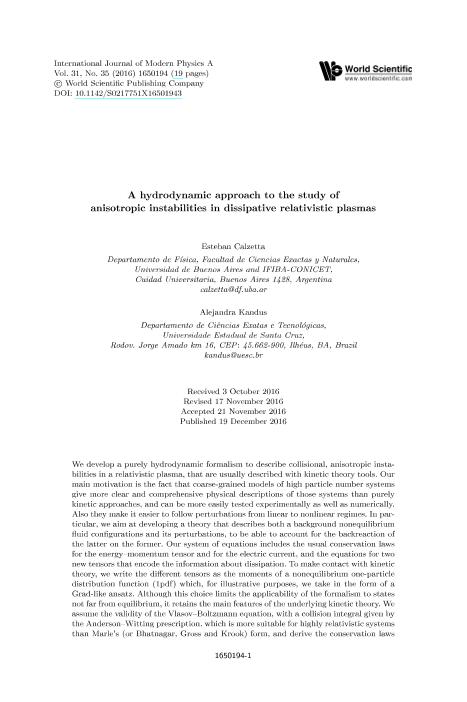Mostrar el registro sencillo del ítem
dc.contributor.author
Calzetta, Esteban Adolfo

dc.contributor.author
Kandus, Patricia

dc.date.available
2018-06-19T15:49:19Z
dc.date.issued
2016-12
dc.identifier.citation
Calzetta, Esteban Adolfo; Kandus, Patricia; A hydrodynamic approach to the study of anisotropic instabilities in dissipative relativistic plasmas; World Scientific; International Journal of Modern Physics A; 31; 35; 12-2016; 1-19
dc.identifier.issn
0217-751X
dc.identifier.uri
http://hdl.handle.net/11336/49273
dc.description.abstract
We develop a purely hydrodynamic formalism to describe collisional, anisotropic insta-bilities in a relativistic plasma, that are usually described with kinetic theory tools. Ourmain motivation is the fact that coarse-grained models of high particle number systemsgive more clear and comprehensive physical descriptions of those systems than purelykinetic approaches, and can be more easily tested experimentally as well as numerically.Also they make it easier to follow perturbations from linear to nonlinear regimes. In par-ticular, we aim at developing a theory that describes both a background nonequilibriumuid congurations and its perturbations, to be able to account for the backreaction ofthe latter on the former. Our system of equations includes the usual conservation lawsfor the energy{momentum tensor and for the electric current, and the equations for twonew tensors that encode the information about dissipation. To make contact with kinetictheory, we write the dierent tensors as the moments of a nonequilibrium one-particledistribution function (1pdf) which, for illustrative purposes, we take in the form of aGrad-like ansatz. Although this choice limits the applicability of the formalism to statesnot far from equilibrium, it retains the main features of the underlying kinetic theory.Weassume the validity of the Vlasov{Boltzmann equation, with a collision integral given bythe Anderson{Witting prescription, which is more suitable for highly relativistic systemsthan Marle´s (or Bhatnagar, Gross and Krook) form, and derive the conservation laws by taking its corresponding moments. We apply our developments to study the emer-gence of instabilities in an anisotropic, but axially symmetric background. For smalldepartures of isotropy we nd the dispersion relation for normal modes, which admitunstable solutions for a wide range of values of the parameter space
dc.format
application/pdf
dc.language.iso
eng
dc.publisher
World Scientific

dc.rights
info:eu-repo/semantics/openAccess
dc.rights.uri
https://creativecommons.org/licenses/by-nc-sa/2.5/ar/
dc.subject
Plasmas
dc.subject
Inestabilidades
dc.subject
Magnetohidrodinamica
dc.subject.classification
Astronomía

dc.subject.classification
Ciencias Físicas

dc.subject.classification
CIENCIAS NATURALES Y EXACTAS

dc.title
A hydrodynamic approach to the study of anisotropic instabilities in dissipative relativistic plasmas
dc.type
info:eu-repo/semantics/article
dc.type
info:ar-repo/semantics/artículo
dc.type
info:eu-repo/semantics/publishedVersion
dc.date.updated
2018-06-12T16:06:00Z
dc.journal.volume
31
dc.journal.number
35
dc.journal.pagination
1-19
dc.journal.pais
Singapur

dc.journal.ciudad
London, UK
dc.description.fil
Fil: Calzetta, Esteban Adolfo. Universidad de Buenos Aires. Facultad de Ciencias Exactas y Naturales. Departamento de Física; Argentina. Consejo Nacional de Investigaciones Científicas y Técnicas. Oficina de Coordinación Administrativa Ciudad Universitaria. Instituto de Física de Buenos Aires. Universidad de Buenos Aires. Facultad de Ciencias Exactas y Naturales. Instituto de Física de Buenos Aires; Argentina
dc.description.fil
Fil: Kandus, Patricia. Universidad de Buenos Aires. Facultad de Ciencias Exactas y Naturales. Departamento de Física; Argentina. Consejo Nacional de Investigaciones Científicas y Técnicas. Oficina de Coordinación Administrativa Ciudad Universitaria. Instituto de Física de Buenos Aires. Universidad de Buenos Aires. Facultad de Ciencias Exactas y Naturales. Instituto de Física de Buenos Aires; Argentina
dc.journal.title
International Journal of Modern Physics A

Archivos asociados
